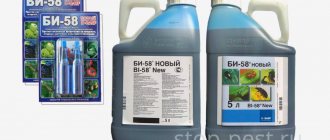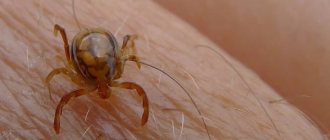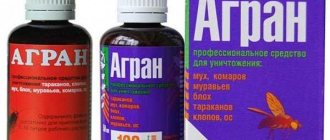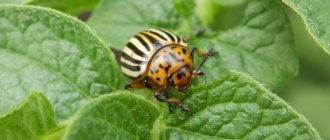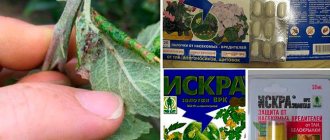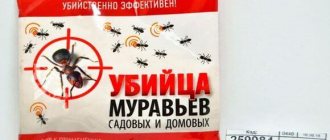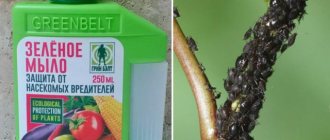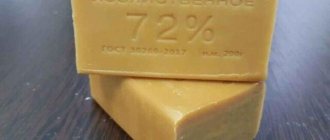Mechanism of action of the drug
When treating cultivated plants with the insecticide Bi 58, the chemical solution directly hits the pests and quickly penetrates the soft tissues of insects (larvae) and their chitinous cover. Dimethoate acts neuroparalytically at the cellular level, causing the death of parasites.
The working solution of the pesticide, prepared according to the instructions, is absorbed by plants during processing and remains in their cell sap for about 25 days. Pests, devouring green plant matter, receive a lethal dose of toxin. This expresses the systemic effect of the drug. Precipitation does not affect its effectiveness.
Application of Bi-58
Compatibility with other drugs
The BI-58 product can be mixed with insecticides and fungicides that do not have an alkaline reaction. Antifungal Strobi and pyrethroid Fastak show good results when used together. Mineral fertilizers are added to the working solution for spraying plants. Foliar fertilizing makes crops resistant to pests.
Upon contact with alkaline drugs, bonds that are toxic to humans are formed and cause poisoning. It is prohibited to use water with clay additives for preparing tank mixtures. Compounds for sprayers with growth stimulants and retardant herbicides are contraindicated.
How to breed Bi 58
In small garden plots, 5 ml packaging of the drug is more often used to treat cultivated crops. The instructions for use indicate that to prepare the solution, the pesticide is diluted with water in the proportion: 1 ml Bi 58 per 1 liter of liquid. Increasing the dosage leads to burns of plants: they turn yellow, shed leaves and may die.
Bi-58 consumption in the table
Description and release form
In the agricultural industry, the drug Bi 58 has established itself as a reliable and universal means for combating gnawing and sucking insects. In terms of its chemical composition, the product belongs to the group of organophosphorus compounds that have a wide range of actions. According to the level of toxicity, it is classified into the third group.
The drug is sold in glass ampoules of 5 ml, bottles of 1 liter, canisters of 5 liters, 10 liters and 20 liters. Externally, the product looks like a dark blue or white liquid. The active substance is a phosphoric acid ester called dimethoate.
This video describes how to use Bi 58 New:
Application of Bi 58
The drug Bi 58 can be used throughout the entire growing season of cultivated plants, with the exception of the last 40 days before harvesting. Pest eggs sometimes remain viable after a single pesticide treatment, so if the plantation is heavily infested with parasites, spraying must be repeated after 2 weeks. The Bi 58 solution prepared according to the instructions is used for the following crops (consumption is indicated for 1 hectare of agricultural land):
| Plant | Its pests | Required amount of drug in liters |
| wheat | bug, grain fly, thrips, aphid | 1,5 |
| barley and other grains | 1,0–1,3 | |
| potato | nematode, Colorado potato beetle, wireworm | 1,6–2 |
| roots | tick, fatty leg | 0,5–1 |
| pulses | weevil, codling moth, aphid, pea weevil | 0,5–1 |
| fruit trees | caterpillar, moth, scale insect | 0,8–2 |
| raspberries | galitza, cicada, tick | 0,6–1,2 |
| grape | wood borer, leaf roller, aphid | 1,2–3 |
Benefits of insecticide
"BI-58" has a number of advantages over other insecticides:
- It is in a liquid state, due to which it begins to act faster (the results of the treatment are visible immediately after 3-5 hours).
- An hour after spraying, it is not washed off by precipitation.
- A fairly long period of protection - from 15 to 20 days.
- The insecticide substance combines well with other drugs against pests, so it can be used for complex spraying of plants (with the exception of poisonous substances with an alkaline environment and/or which contain copper. Since in an alkaline aqueous environment the main substance of the insecticide is hydrolyzed, and as a result this the substance is destroyed).
- Wide range of crops that can be processed (cereals and legumes, fruit trees, root vegetables and cruciferous plants).
- Effective against various types of pests.
- The drug has not only an insecticidal, but also an acaricidal effect.
- Not phytotoxic.
- Wide temperature range of application.
- The drug allows you to choose the optimal consumption rates.
- "BI-58" has an affordable price.
Special instructions and precautions
When using Bi 58 to protect plants from pests, the following safety precautions must be observed:
- All work on preparing the working solution and using the chemical must be carried out in closed shoes, a suit, rubber gloves, a respirator and safety glasses.
- It is recommended to dilute the product with water immediately in a garden sprayer bottle.
- After irrigating the plants with insecticide, wash the equipment and take a shower with soap.
- Do not pour the remaining chemical onto the ground or into a body of water.
- Bi 58 belongs to hazard class 3, toxic to bees and fish. Before using this pesticide, it is necessary to limit the access of pets to the garden.
- Plants treated with insecticide can be eaten no earlier than 40 days after spraying.
Preparing the garden sprayer for use
Composition and action
DV Bi-58 dimethoate (formula in the figure on the right) belongs to the chemical class of organophosphorus compounds (OPS). The mechanism of action is a nerve poison (neurotoxin) that blocks the enzyme-mediator cholinesterase. The result is failure of nerve impulses to reach the muscles, convulsions, paralysis and death.
Chemical formula of dimethoate, the active ingredient of the Bi-58 pesticide, and its structural model
Toxicology
Like other neurotransmitter (transport enzyme) blockers, dimethoate is a rather slow but very strong poison. It is weakly selective towards taxonomic groups of animals, because Cholinesterase is a universal mediator of nervous control of muscles. The toxicity of dimethoate for warm-blooded animals increases with increasing metabolic rate, so working with Bi-58 in hot weather requires additional precautions, and for birds this pesticide is almost less dangerous than for the objects being eliminated. Also - for fish and aquatic organisms due to good solubility in water (39 g/l); the same factor determines the environmental hazard of the drug in rainy weather.
For humans, Bi-58 is especially dangerous in case of inhalation (inhalation) of splashes of the working solution (this is what causes accidents in agricultural production) or contact with mucous membranes. Inhalation of vapors is less (but still very) dangerous, because The volatility of the additive is low (0.107 mg/cubic m at +25 degrees Celsius). It is also very dangerous if the drug gets on the body, because it is quickly, within a few minutes, completely absorbed into the body through dry, intact skin (through mucous membranes - instantly). Toxicological indicators of dimethoate are close to threatening:
- LD50 for rats 230 mg/kg body weight; for mice 135 mg/kg;
- ADI for humans is 0.002 mg/kg.
- TAC in soil is 0.1 mg/kg.
- MPC in water of reservoirs is 0.003 mg/cubic meter. dm social-t.
- The maximum permissible concentration in the air of the working area is 0.5 mg/m3. m.
- MPC in atmospheric air is 0.0003 mg/cubic meter. m s.-s.
Note: the content of dimethoate vapor in the air is 10 mg/m3. m is 100% lethal for rats, and 3 mg/cu. m for most laboratory animals. The lethal dose of dimethoate applied to the skin of mammals ranges from 1-1.5 g/kg.
Acute poisoning with dimethoate develops gradually, over 1-3 days. Initial symptoms are general weakness and drowsiness. Then you feel chills, nausea, vomiting, and profuse sweating begin. In case of moderate poisoning, this is followed by tremors, loss of coordination of movements, a wobbly “drunk” gait, and constriction of the pupils. In case of severe poisoning, clonic convulsions begin, turning into local paralysis, then a coma is observed. Death occurs due to impaired cardiovascular activity. There is no specific antidote, treatment is symptomatic.
Terms of sale and storage
The chemical must be stored in a dark place away from children and animals. The optimal storage temperature is + 18-25°C. The shelf life of Bi 58 is 2 years from the date of issue (indicated on the label). The working solution prepared according to the instructions cannot be stored. After use, its residues should be disposed of.
Use of Bi-58
Analogs
If for some reason the selected plant protection product against pests is not available, you can use a product with a similar effect. Insecticide Bi 58 has analogues in which the active substance is also dimethoad:
- Rogor. The drug is available in the form of a concentrated solution in 10 liter canisters. The dimethoate content in Rogor is 400 ml per 1 liter of the drug. When the product comes into contact with a pest, there is an immediate paralytic effect. The death of the insect occurs within 3 hours. The drug has a prolonged effect - protection of treated crops lasts up to 20 days.
- Phosfamide is an organophosphate chemical. Dimethoad, the active ingredient, makes up 40% of the drug. The insecticide poisons pests through contact and systemic effects on crop parasites when they eat treated plant parts. Phosfamide is sold in 10 liter canisters.
- Emphasis – contact-intestinal poison against insect pests. Destroys parasites at all stages of development. The content of dimethoad is similar to the drugs described above. The insectoacaricide is used to destroy many insect pests on plantations of wheat, barley, sugar beets, vineyards, apple trees, peas and other crops.
- Dimethrin is an organophosphate insecticide in the form of a concentrated emulsion. 1 liter of the drug contains 400 ml of dimethoad, a neuroparalytic substance that paralyzes pests on agricultural crops with their subsequent destruction. It is toxic to humans, therefore it requires preparation of the working solution strictly according to the instructions and compliance with safety precautions during use.
When and where is the product used?
The drug Bi 58 protects all parts of plants, including newly growing ones, from pests. The insecticide is well tolerated by most crops. It can be used to process:
Read on topic:
Sulfur ointment: instructions for use, price and reviews
15.10.2019
Get Total - a modern means for effective control of insects
25.06.2019
Getting rid of cockroaches and bedbugs with Xulat Micro
25.06.2019
Xulat C25 - a powerful modern remedy for cockroaches and bedbugs
25.06.2019
- cereal crops - wheat, oats, millet, barley;
- leguminous plants;
- fruit trees - apples, pears, plums;
The drug Bi 58 will help protect fruit trees from herbivorous parasites
- vineyards;
- citrus fruits;
- vegetable crops - beets, cabbage, potatoes;
- berry bushes - raspberries, currants, gooseberries;
When treating berry bushes with Bi 58, the drug will help kill the insects that live on them
- alfalfa and flax.
In addition to use in garden plots and farmland, the drug can be used to treat indoor plants and treat plantings in greenhouses.
The insecticide has a wide spectrum of action. It is most often used to combat the Colorado potato beetle at all stages of development of this insect. In addition, the drug helps cope with different groups of pests:
- sawfly beetles;
- aphids and thrips;
- bedbugs;
The product Bi 58 not only helps in the fight against the Colorado potato beetle, but can also help get rid of bedbugs
- caterpillars;
- codling moths;
- butterflies - cutworms, moths, leaf rollers, etc.;
- flies and whiteflies, as well as their larvae;
- flea beetles that parasitize plants;
- mites and scale insects.
Price Bi 58
| Seller (Moscow) | Volume | Cost in rubles |
| LLC "Vozrozhdenie" | 5 l | 750 per 1 l (for orders over 40 l) |
| Sadovod store, Zeleny pr., 3A | 5 ml | 35 |
| 2 x 5 ml | 60 | |
| BAU BASE LLC | 10 l | 4400 |
| RADONEZH-AGRO | 5 ml | 30 |
| DEZ24 | 5 l | 4500 |
| Trading house "Brig" | 5 ml | 16 |
